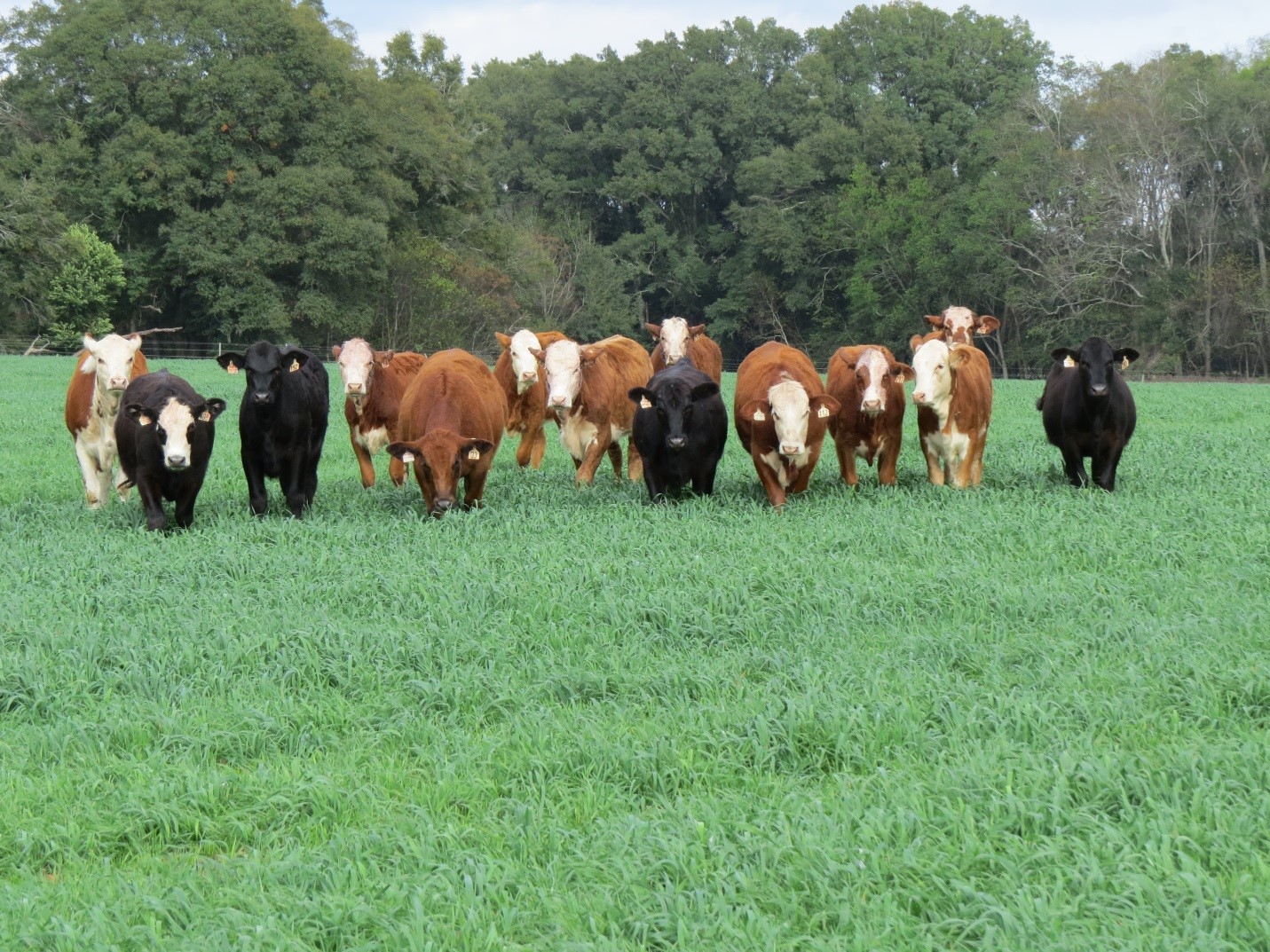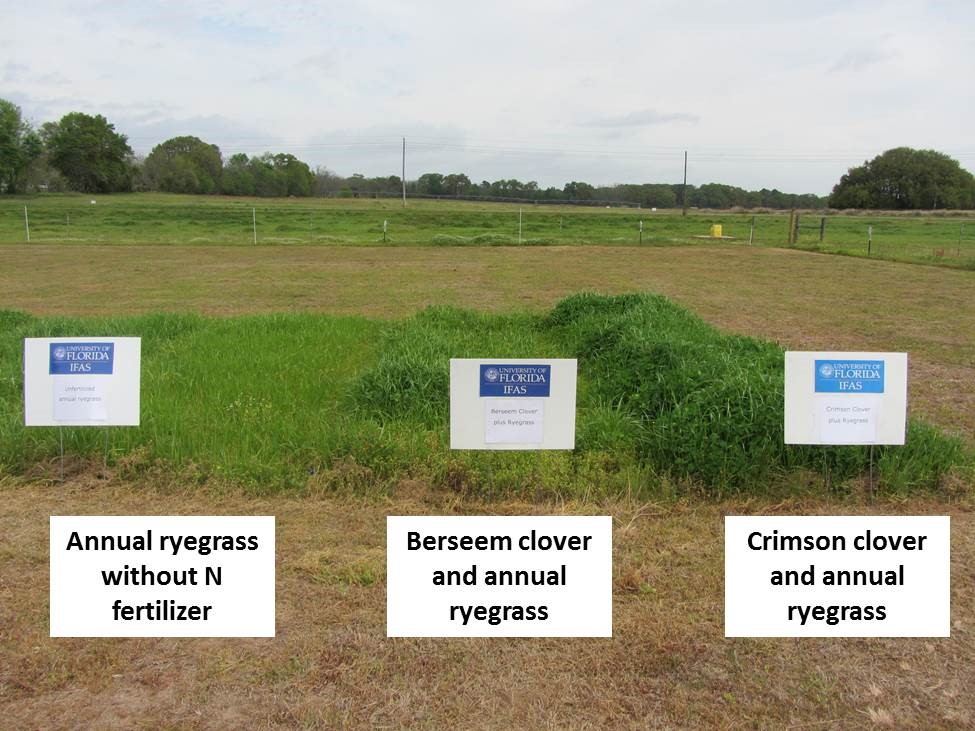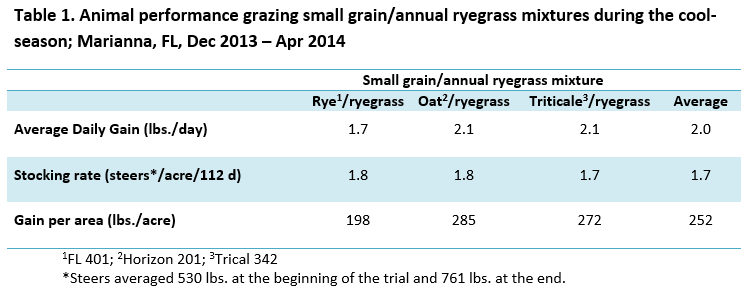
Replacement heifers on cool-season forages, Dec. 6, 2013 at the North Florida Research and Education Center (NFREC), Marianna, FL. Photo credit: Jose Dubeux.
Jose Dubeux – NFREC Forage Management Spcialist dubeux@ufl.edu
Cool-season forages are a viable option for North Florida. They extend the grazing season by providing high quality forage to enhance livestock performance. There are many options available, including annual cool-season legumes, annual ryegrass, small grains, and their mixtures. These forages can be no-till drilled on dormant warm-season grass pastures (e.g. bahiagrass, bermudagrass), or planted in another area. In fact, both options could be used on the same farm. Because there might be delays on the first frost, and consequently a delay in the no-till planting on dormant warm-season grass, it can be useful to set aside a smaller area of tilled land that can be planted earlier. Thus, this area would provide forage for the early season, whereas the no-till drilled area would provide forage late into the spring.
Mixing forages with distinct seasonal growth patterns extends the grazing season as well. Small grains such as Cereal Rye (Secale cereale L.), Triticale (x Triticosecale Wittmack), and Oat (Avena sativa L.) grow earlier in the season, compared to annual ryegrass. Mixing small grains with annual ryegrass provides a longer season of growth. Performance of these mixtures will vary with selected cultivars. Some early small grain varieties (e.g. FL 401 cereal rye) provide forage for grazing earlier in the Fall. During this period, the stocking rate needs to be adjusted to the herbage mass in order to match the forage growth rate. Later into the season, the cereal rye will reduce its growth rate. Other small grains such as Triticale and Oat also provide some Fall growth, supplying forage before the annual ryegrass season starts. Once the annual ryegrass season starts, it will provide high quality forage leading to greater livestock performance. From December 2013 to April 2014, researchers compared three small grain/annual ryegrass mixtures and measured animal performance. The average daily gain for all combinations was 2 pounds/head over the 112 day test (Table 1). This gain is approximately three times greater than the gain typically observed for livestock grazing bahiagrass pastures during the summer. Thus, cool-season forages give an opportunity to increase productivity on the same land area, enhancing the efficiency of livestock operations in the Panhandle.
Replacement heifers, first calving heifers, lactating cows, and calves demand greater nutrient intake, per unit of live weight, to meet their needs. These groups should have priority access to cool-season forages, if the planted area is not enough for the entire herd. Creep grazing is also an option, giving special access to young calves to cool-season pastures.
Adding cool-season legumes to the small grain/annual ryegrass mixture will add nitrogen (N) via biological fixation. The N fixed by legumes can be transferred to the companion grass mixture via cattle waste and decomposing leaves. Savings in N fertilizers will offset total costs. Legume variety options available include clovers such as crimson, Ball, red, white, berseem, and balansa. Information on planting dates and seed rates for cool-season forages are available at EDIS publication SS-AGR-150, Planting Dates, Rates, and Methods of Agronomic Crops

Annual ryegrass and cool-season legume mixtures contrasted with annual ryegrass without N fertilizer; Marianna, FL, Apr. 2014. Photo by Jose Dubeux on April 7 2014.
The Florida Panhandle offers a unique opportunity to grow forage almost year-round. Cool-season forages greatly enhance livestock performance and increase efficiency of livestock operations. Early preparation is the key to success of cool-season pastures. The most popular cultivars sell first, so develop your plan and order your seed. Planting time is a little more than a month away.
For More Information:
Cool Season Forage Planting Decisions
2013 Cool-Season Forage Variety Recommendations for Florida
Tillage and Overseeding Pastures for Winter Forage Production in North Florida
- 2025 UF/IFAS Forage Legume Conference – May 1 - March 28, 2025
- How are My Cool-season Forages Recovering from the Snowfall and Low Temperatures? - January 31, 2025
- Integrated Crop-Livestock Systems Improve Soil Health - July 26, 2024

